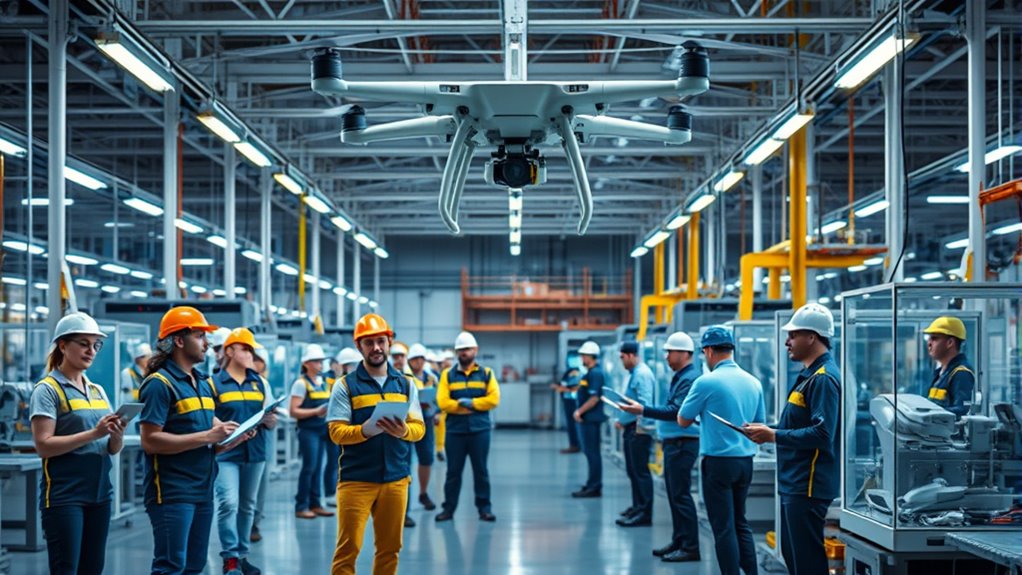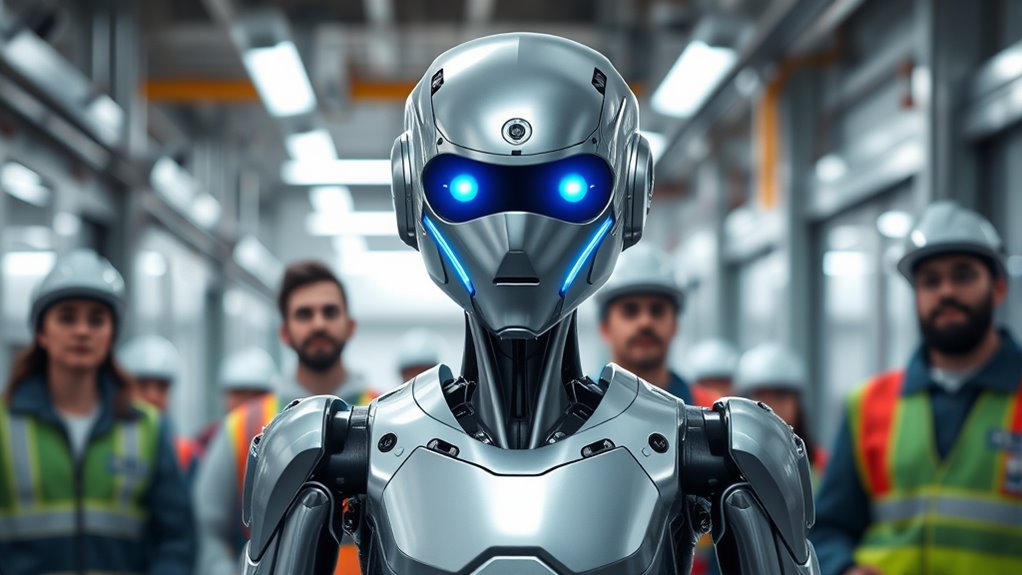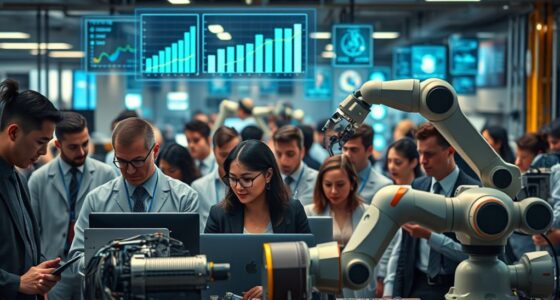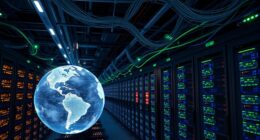AI can be both a big helper and a form of surveillance at work. It streamlines tasks, boosts productivity, and offers real-time insights, making your job easier. But, it also tracks your every move, raising privacy concerns and stress. Finding the right balance between support and monitoring is vital. Want to discover how organizations are managing this tightrope walk and what it means for you? Stay with us to explore more.
Key Takeaways
- AI can enhance productivity and provide real-time insights, acting as a supportive helper rather than intrusive surveillance.
- Excessive monitoring may erode trust, increase stress, and reduce motivation, turning AI into a “Big Brother.”
- Transparent use of AI surveillance and employee involvement foster a positive environment where AI assists rather than polices.
- Balancing privacy concerns with technological benefits is crucial to ensure AI functions as a helpful tool.
- Responsible AI implementation aligns with organizational values, promoting assistance over intrusive oversight.
The Growing Role of AI in the Modern Workplace

AI is increasingly transforming the modern workplace, with 78% of organizations adopting it in 2024—up from 55% just a year earlier. You’ll find AI tools integrated into daily operations, boosting productivity and streamlining tasks. Over half of managers now use AI regularly to manage employees, making automation a key part of leadership. While automating half of current tasks worldwide could take decades, AI is already helping workers in tech and finance view it as an opportunity for growth. Businesses are shifting from viewing AI as a threat to seeing it as a strategic asset, focusing on efficiency and innovation. As contrast ratio continues to improve, the quality of AI-driven visualizations and interfaces will enhance user experiences across industries. By 2030, the skills required for work will change dramatically, emphasizing the importance of adapting to this evolving AI landscape. Global job loss estimates suggest that 300 million jobs could be affected by AI worldwide, highlighting the urgency for workforce adaptation.
Employee Concerns About Job Security and AI

You’re likely worried that AI could threaten your job security, especially as many roles face automation risks. Concerns about needing retraining or fearing limited opportunities for career growth are growing among workers like you. As AI continues to reshape workplaces, it’s natural to question how you can adapt and stay relevant. Developing a solid understanding of financial terms and jargon, such as investments and diversification, can also help you make informed decisions about your financial future amidst these changes. Additionally, understanding essential oils for workplace stress may provide you with effective strategies to manage anxiety during these uncertain times. Nearly 50 million US jobs may be impacted by AI in the coming years, highlighting the importance of proactive upskilling and adaptation.
Job Security Anxiety
Are workers truly prepared for the rapid rise of automation in the workplace? Many of you feel anxious about job security, with 89% worried about AI’s impact. Nearly a third fear your job might be replaced by AI by 2025. The threat feels real: 14% have already lost jobs to AI, and 60% of roles in advanced economies could be at risk. Automation might take over half of your tasks within 20 years, and 44% expect AI to handle some of your work soon. Workplace bias and lack of transparency deepen your worries, with over half feeling unsure about AI plans. Understanding workplace bias and transparency issues can help mitigate some of these concerns. Current impact shows 14% of workers have experienced job loss due to AI or automation, highlighting the immediate concerns. Additionally, the workforce adaptation process remains a significant challenge for many employees facing these technological changes. Recognizing employee resilience and strategies for upskilling are essential for navigating this transition. Here’s a quick look at the current landscape:
| Concern Area | Statistic |
|---|---|
| Workers fearing job loss | 89% |
| Jobs displaced by AI | 14% |
| Tasks at risk in 20 years | 50% |
| Expect AI to take tasks | 44% |
| Risk in advanced economies | 60% |
Need for Retraining
As technological advancements accelerate, the need for retraining becomes more urgent to keep pace with evolving job roles. AI’s rapid progress creates a skills gap that demands immediate attention. You’ll need to learn new technologies and adapt to changing responsibilities as AI automates or augments tasks. Companies are recognizing this, making reskilling a core part of their strategy to balance workforce supply and demand. Clear communication from employers about AI’s role in enhancing jobs helps ease anxiety about job security. Upskilling isn’t just a choice; it’s a strategic necessity to prepare you for future changes and stay competitive. Continuous learning and flexible training programs, often powered by AI tools, are essential to keeping your skills relevant in this fast-changing environment. Incorporating retraining options that focus on developing skills in innovative tools and technologies will be vital in bridging the skills gap. Recognizing the importance of electric power generation can inspire new skill sets related to sustainable energy solutions within the workforce. Emphasizing personal growth through ongoing education can also foster resilience and adaptability in the workforce. Additionally, understanding how AI-driven data analysis can inform workforce development strategies allows organizations to better align employee skills with future needs. Staying informed about skills gap trends can help both employees and employers proactively address potential shortages in critical competencies.
Career Advancement Concerns
With AI rapidly transforming workplaces, many employees worry about how these changes will affect their career prospects. You might fear losing your job, especially since 30% of workers expect AI to replace their roles by 2025. Displacement is already happening, with 14% of workers displaced by AI, and 60% of jobs in advanced economies at risk. Entry-level opportunities could shrink, impacting nearly 50 million US jobs, and social mobility may suffer as AI alters the talent pipeline. You may also worry about your future growth; employers reduce workforce where AI can automate tasks, and many roles that once required specialized skills become more accessible. These shifts threaten job security and create uncertainty about career advancement in an AI-driven workplace. Recognizing the self-centered tendencies that can emerge during times of change can help individuals maintain healthy perspectives and adapt more effectively. Incorporating wall organization systems and stylish home decor solutions can help create a more comfortable and organized environment during these uncertain times. Understanding the importance of sound healing science can also provide mental clarity and stress relief amidst workplace uncertainties. Additionally, understanding the all waterparks industry can offer insights into innovative leisure solutions that promote employee well-being and stress management.
Surveillance Technologies Transforming Work Environments

You’re likely aware that many companies use digital tools like online tracking and biometric access, alongside physical surveillance such as video cameras, to monitor employees. These technologies can boost security and productivity but also raise serious privacy concerns and risks. Understanding how these tools transform work environments helps you navigate their benefits and potential pitfalls. Substantial employee monitoring statistics highlight how widespread these practices are, with over 73% of employers tracking remote or hybrid workers. The integration of advanced surveillance technologies continues to evolve, influencing workplace dynamics significantly, especially as organizations balance privacy considerations with operational needs. As cybersecurity vulnerabilities can be exploited during these monitoring practices, implementing security protocols is essential to safeguard sensitive information. Additionally, the development of AI-driven monitoring solutions raises questions about ethical implications and the future of workplace privacy.
Types of Monitoring Tools
A variety of monitoring tools are transforming work environments by providing employers with detailed insights into employee activities. Time-tracking software logs when you start, stop, and how long you work, often integrated with project and payroll systems to identify productivity patterns and bottlenecks. Productivity monitoring software takes screenshots and tracks application usage, websites, and document changes, sometimes even keystrokes, as seen with tools like Teramind. Video and audio surveillance are increasingly common, with some tools recording audio or using stealth modes to remain hidden. Location tracking now monitors exact GPS coordinates, especially for remote or field workers, often outside work hours. Ultimately, web filtering and data loss prevention tools restrict browsing and protect sensitive data, ensuring security but sometimes limiting legitimate activity.
Physical vs. Digital Surveillance
Surveillance technologies in the workplace can be broadly categorized into physical and digital methods, each with distinct characteristics and implications. Physical surveillance includes video cameras, biometric access controls, badge reader logs, camera motion logs, and visitor logbooks. These tools are visible and often used to enhance security, monitor movement, and track on-site access. In contrast, digital surveillance involves tools like productivity tracking software, remote monitoring platforms, and online activity analysis. These methods are less noticeable but can feel invasive, especially when tracking computer usage or online interactions. While physical surveillance emphasizes security, digital methods focus on monitoring productivity. Both types are increasingly integrated, especially in hybrid work environments, but digital surveillance tends to generate more employee resistance due to privacy concerns.
Privacy Concerns and Risks
As AI monitoring becomes more prevalent in the workplace, concerns about privacy erosion intensify. You might feel that your personal space is shrinking, with AI tracking everything from screen activity to keystrokes and work hours. This constant surveillance blurs the line between your professional and private life, often making you anxious or pressured. You could worry about:
- Being watched even in your home workspace
- Data misuse or profiling beyond work-related purposes
- Reduced autonomy and increased stress
- Lack of transparency about what data is collected and how it’s used
These issues can decrease morale, stifle creativity, and impact your mental health. The rapid growth of surveillance technology outpaces current laws, leaving gaps in your protections and raising serious ethical questions about privacy in the modern workplace.
Psychological Impact of Monitoring on Workers

Monitoring at work often leads to increased stress and psychological distress among employees. Over half of monitored workers report feeling tense or stressed compared to 40% of unmonitored colleagues. The presence of surveillance acts as an initial stressor, which can trigger further stress through stress proliferation, negatively affecting mental health and job satisfaction. Nearly half of workers see surveillance as an invasion of privacy, reducing their sense of control and autonomy, which worsens overall well-being. Many feel untrusted, leading to lower morale, strained workplace relationships, and diminished trust. About 37% link surveillance directly to declining mental health, citing anxiety and heightened stress. Continuous monitoring can hinder learning, decrease motivation, and impair productivity, creating a cycle that harms both psychological health and professional growth.
Balancing Productivity and Privacy Rights

Balancing productivity and privacy rights has become a central challenge as AI technologies increasingly permeate workplaces. You’re tasked with harnessing AI’s benefits without infringing on employee privacy. To do this effectively, consider these points:
- Recognize that AI monitoring affects over two-thirds of U.S. workers, raising privacy concerns.
- Understand that excessive surveillance can reduce productivity and lead to dissatisfaction.
- Use AI tools that provide developmental feedback rather than just monitoring behaviors.
- Clearly communicate the purpose of AI systems to foster trust and acceptance among employees.
How AI Enhances Employee Capabilities

AI streamlines your work by automating repetitive tasks and giving you real-time insights, so you can focus on more strategic activities. This boosts your productivity and helps you make faster, more informed decisions. As a result, your skills are amplified, and your capacity to handle complex challenges grows.
Automating Repetitive Tasks
Automating repetitive tasks can considerably enhance your productivity by freeing up time for more strategic and creative work. With nearly 50% of your current activities being automatable, you can focus on higher-value tasks. AI works tirelessly, speeding up processes and improving accuracy, leading to benefits like:
- Reduced processing times by 70-90%
- Saving 240–360 hours annually per employee
- Lower stress levels for 65% of workers
- Effortless scaling of operations
Automation also cuts costs, with some companies reducing expenses by up to 30%, while reallocating employee hours fosters innovation. As a result, you can shift toward more meaningful work, leveraging AI to handle routine chores efficiently and freeing your capacity for strategic growth.
Providing Real-Time Insights
Real-time insights transform how you manage employee performance by providing immediate, data-driven feedback. AI systems constantly gather data, offering a exhaustive view of performance rather than sporadic reviews. This continuous monitoring helps you identify issues early and intervene proactively. AI-driven analytics reduce bias in evaluations by up to 50% by 2025, promoting fairness. With tailored feedback and benchmarks, employee productivity can increase by 25%. AI also predicts potential performance problems, allowing you to address them before they escalate. Real-time alerts notify you of project delays or performance dips for swift action. By providing instant, personalized insights, AI empowers you to make better decisions, boost engagement, and foster a culture of continuous improvement and accountability.
Generational Perspectives on AI and Surveillance

- High familiarity with smart devices doesn’t mean trust in AI security.
- Many prefer traditional passwords over AI-based security, fearing privacy breaches.
- Adoption of AI tools is higher among younger generations, but skepticism remains.
- Transparency and privacy concerns hinder widespread acceptance of AI monitoring.
Your views on AI security are influenced by these generational differences.
Regulatory Frameworks Shaping Responsible Use of AI

As organizations adopt AI tools despite lingering privacy concerns, the evolving regulatory landscape plays a crucial role in guiding responsible use. Global fragmentation means a single, unified framework is unlikely soon, so regional standards vary widely. Agile governance models are essential to adapt quickly to this patchwork of regulations, which include mandatory and voluntary frameworks. Stricter laws emphasize compliance, security, and data sovereignty, compelling organizations to align their AI strategies with regional requirements. Key legislation introduced in 2025, along with GDPR, CCPA, and the EU AI Act, shape accountability standards and transparency. Compliance becomes critical for trust and risk mitigation, pushing businesses to integrate security and adapt to regional data laws. Proactive governance and regulatory collaboration are vital for steering this complex, evolving environment responsibly.
Strategies for Fostering Trust in AI Integration

Building trust in AI integration requires deliberate strategies that engage both leadership and employees. To succeed, focus on transparent communication about AI’s goals and benefits, addressing concerns like job security openly. Involve workers in decision-making processes to boost confidence and ownership. Celebrate small wins to demonstrate AI’s positive impact and reinforce trust. Establish clear governance policies to ensure responsible AI use. You should also promote an open dialogue about AI’s role, encouraging continuous feedback. Providing AI training and involving workers in development fosters inclusivity and understanding. Consider forming partnerships with unions for equitable integration. These steps help build a culture of trust, making employees more receptive and confident about AI’s role in the workplace.
Future Trends in AI-Assisted Work and Oversight

The future of AI-assisted work and oversight is rapidly evolving, with organizations increasingly adopting advanced solutions to enhance productivity and decision-making. You’ll see companies moving beyond basic automation to embrace sophisticated analytics, predictive modeling, and real-time insights that optimize operations. Despite only 1% reaching full AI maturity in 2025, many are still in early or intermediate stages, expanding AI’s role in talent management, workforce planning, and performance prediction. AI tools will become more personalized, offering tailored feedback and career development suggestions. Meanwhile, balancing surveillance with support remains essential, as transparency and privacy protections are indispensable to maintain trust. Expect AI to become a critical partner in workplace efficiency, employee experience, and strategic oversight, shaping a future where humans and machines collaborate more seamlessly.
Frequently Asked Questions
How Can Companies Ensure Ethical AI Surveillance Practices?
To guarantee ethical AI surveillance, you should prioritize transparency by clearly informing employees about data collection and its purpose. Regularly audit your datasets to prevent bias, and involve third-party oversight for accountability. Protect privacy through data minimization and security measures, and give employees access to their data while providing channels for concerns. Following legal standards like GDPR and CCPA helps maintain trust and fairness in your surveillance practices.
What Training Is Available for Employees to Adapt to AI Tools?
You can access a variety of AI training programs designed to help you adapt to new tools. These include AI-powered assistants, personalized e-learning platforms, microlearning modules, and interactive simulations. Many companies invest in digital training that’s scalable and tailored to your needs, allowing you to develop skills efficiently. By engaging in these trainings, you’ll improve your work quality, stay current with technology, and boost your overall performance in the workplace.
How Does AI Impact Team Dynamics and Collaboration?
You might be surprised to learn that AI adoption boosts team engagement by 79%. It strengthens communication, fosters inclusivity, and enhances collaboration through data-driven insights. By automating routine tasks, AI reduces stress and burnout, allowing you and your team to focus on creative problem-solving. When leadership guides effective AI integration, team dynamics improve markedly, leading to higher productivity, stronger connections, and a positive workplace culture that propels your organization forward.
Are There Legal Limits to Workplace Monitoring With AI?
You should know there are legal limits to workplace AI monitoring. Laws like the NLRA protect your rights, ensuring monitoring doesn’t interfere with union activities or privacy expectations. Employers must conduct case-by-case analyses, involve employees in planning, and limit data access. Oversight by agencies like the NLRB ensures fair use, and regular audits help keep surveillance lawful and ethical. Restrictions aim to balance operational needs with your privacy rights.
How Do Cultural Differences Influence AI Acceptance at Work?
Cultural differences shape how you perceive AI at work, like colors in a painting. In collectivist societies, you might see AI as a helpful partner, embracing its supportive role. In contrast, individualistic cultures may view AI with suspicion, fearing loss of control. Your trust depends on societal values, media influence, and education. Recognizing these differences helps organizations develop culturally sensitive AI strategies that foster acceptance and collaboration.
Conclusion
As you navigate the evolving workplace, remember that AI can be both a helpful ally and a watchful eye. For example, a company implemented AI tools that boosted productivity without invading privacy, fostering trust among employees. Striking this balance means embracing transparency and respecting boundaries. By doing so, you can guarantee AI serves as a helpful partner rather than a Big Brother, creating a safer, more productive environment everyone can thrive in.









